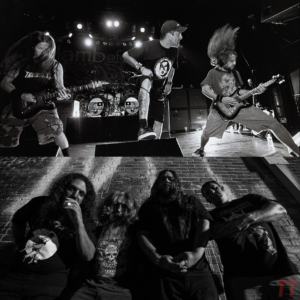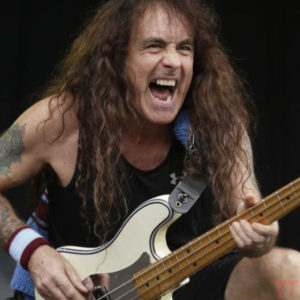Metallica Tech Reveals One Challenge Metallica Faced After Switching to Axe-Fx, Speaks on Evolution of Band’s Rig
“At that point, I think both Chad [Zaemisch] and myself realized, ‘Oh, we we’re not necessarily going after the same…’ That was literally a eureka moment for both of us.”

Kirk Hammett’s longtime guitar tech Justin Crew commented on the evolution of Metallica’s rigs, and noted some of the challenges that came up after the thrash giants switched to Fractal ditigal amps for their weapons of choice.The world’s biggest metal band has been riding the digital train for quite a while, and it’s no secret. “James and I instantly realized that this was what we were looking for this whole time”, Kirk Hammett said a few months ago, and the audiences definitely haven’t suffered for it.

“We’ve embraced technology, and it’s been good to us”, Kirk’s longtime guitar tech Justin Crew similarly said during a recent interview with Doug Doppler Music. Asked to comment on how the Metallica guitar rigs evolved over time, Justin, whose arrival to the Metallica family coincided with the (in)famous 1996 “parking lot” gig at Tower Records in San Jose, said (transcribed by Ultimate Guitar):
“When I started, we were [running] TriAxis, a clean and lead with rack-mounted rectifier heads, with a Bradshaw pedalboard. There was a Whammy pedal in the middle of it somewhere… Strategy 400 powering the iso cabinets; powering the speakers on stage… Slowly went to the Randall Egnater with the plugin modules. Then, the Fortin Meathead modified for Kirk — solid amp, never let me down.”
Justin notes how it all drastically changed after Metallica became the first band in history to play on all seven continents with the 2013 “Freeze ‘Em All” show in Antarctica, as his colleague Chad Zaemisch recently confirmed:
“When we went to Antarctica, everything had to be solar-powered, [and] we wound up with the Fractal. With the fractals, it’s identical across the board. We’re not micing up, speakers that are wet because it’s humid; it’s all very, very consistent. When they’re in the tuning room, they’ll plays some of the songs that we’re going to play that show.”
Crew adds that the whole point of this is to keep the consistency with every show and to make the band members feel as comfortable as possible. “Because we can do things with the Fractal that we can’t do with a real amp,” he explained, “and the noise floor is so much lower.”
The challenges of digital amps
However, the switch to Fractal came with some unexpected challenges that eventually became another win in favor of the newer tech. Asked if Metallica ever found itself in a situation where they captured a great guitar sound, only to find out that it didn’t work in the whole mix and had to recapture the guitar, Justin answered:
“Totally. When we first started, because we were using iso cabs in the tube amp world, we found that that warmth, where the cabinet kind of struggles to breathe because it’s pushing against these four walls… It took us a long time to emulate that in the Fractal. And then we sat James down with it, all pleased about ourselves, because it took us two days to get back together, and James went, ‘Yeah, but still got that annoying thing about it with the iso cabinet.”
After making a few modifications, Justin and Chand got to an “eureka” moment:
“At that point, I think both Chad [Zaemisch] and myself realized, ‘Oh, we we’re not necessarily going after the same. We’re going after better!’ That was literally a eureka moment for both of us. We realized we got to stop thinking like it has to be the same as what they had, because we can do better.”
“And yes, once you get the whole band going, then it can maybe not fit. We recently tried approximating the sound of ’72 Seasons’ and we went more in that direction with Kirk. But then, once Greg FIdelman [producer] had heard the recording, he was like, ‘Ah, sounds great on its own, [but] it just doesn’t sit in the mix, right. Can you go back?’ So we did. And now everything’s happy.”
News
These 5 Guitarists Are the Greatest Disciples of Jimi Hendrix tt
These 5 Guitarists Are the Greatest Disciples of Jimi Hendrix The Voodoo Child’s musical offspring. There’s no denying the immense influence Jimi Hendrix had on guitar playing. All you have to do is give a listen to some of the…
‘It’d Be Hard for Me to Name One Song’: Michael Sweet Explains Why He’s ‘Never Been a Big Fan of Metallica’ tt
‘It’d Be Hard for Me to Name One Song’: Michael Sweet Explains Why He’s ‘Never Been a Big Fan of Metallica’ “But hey, man, God bless ’em.” Michael Sweet admitted he wasn’t a big fan of Metallica even though he…
After This Album, Metal Music Was Changed Forever: 20 Years Later, and It Still Holds Up! tt
After This Album, Metal Music Was Changed Forever: 20 Years Later, and It Still Holds Up! A visionary mix of thrash, groove, and death metal from the New Wave of American Heavy Metal’s finest. 173,950 views · 31 comments Share During the…
‘Metallica’s Not Running Tape’: David Ellefson Explains Why Bands Shouldn’t Use Backing Tracks, Says Some Mistakes Are ‘Beautiful’ tt
‘Metallica’s Not Running Tape’: David Ellefson Explains Why Bands Shouldn’t Use Backing Tracks, Says Some Mistakes Are ‘Beautiful’ “Sometimes, the mistakes are beautiful.” It seems like nowadays, more and more music artists are relying on playing along with pre-recorded or…
Jason Bonham Leaves The Best of All Worlds Tour Due to Family Emergency, Watch the Band Play With New Drummer. tt
Jason Bonham Leaves The Best of All Worlds Tour Due to Family Emergency, Watch the Band Play With New Drummer Sammy Hagar, Michael Anthony, and Joe Satriani have already played with a replacement drummer behind the kit. Drummer Jason Bonham…
Steve Harris Reveals Why He Prefers Fender Precision Basses: ‘I’ve Tried a Lots of Others Over the Years, but…’ tt
Steve Harris Reveals Why He Prefers Fender Precision Basses: ‘I’ve Tried a Lots of Others Over the Years, but…’ “The position just always felt right for me.” Steve Harris revealed why he prefers to use Fender Precision basses. In an…
End of content
No more pages to load











